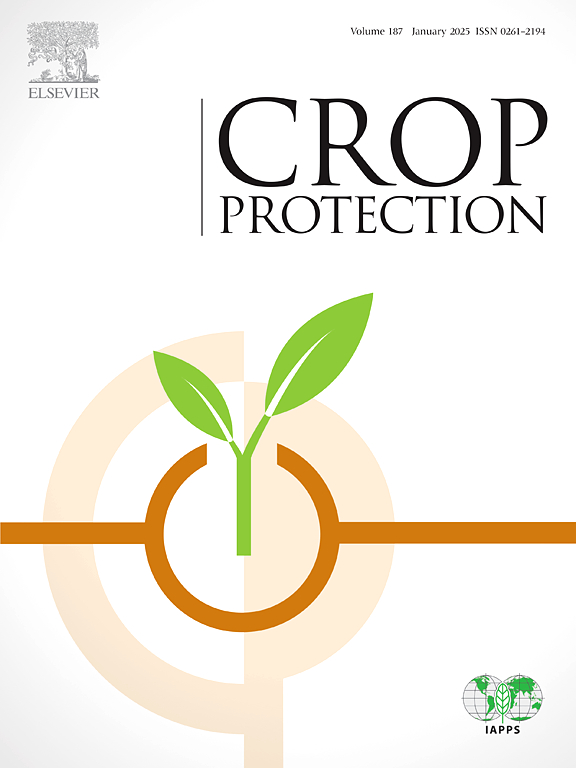Spray volume adjustment for pesticide applications against aphids in citrus: Validation of CitrusVol tool
IF 2.5
2区 农林科学
Q1 AGRONOMY
引用次数: 0
Abstract
Aphids are key pests of citrus in Spain. The most abundant aphid species in Mediterranean citrus are Aphis gossypii and Aphis spiraecola. Foliar applications of pesticides are commonly used with aphid management programs. However, these applications are usually carried out in a non-optimised way, using water volume rates that are higher than necessary. CitrusVol is a decision support tool that recommends an optimal volume rate adjusted to the vegetation characteristics, the pest, and the pesticide. It has been validated for other important citrus pests such as Aonidiella aurantii and Tetranychus urticae but not for aphids. In this work, the Proof-CitrusVol version was evaluated by comparing the aphid control efficacy of applications adjusted using the tool versus conventional higher-volume applications. Based on insufficient aphid control during the initial year of field testing, the tool was modified, and a new version was subsequently validated. The field trial results showed that CitrusVol reduced the spray volume by 29% on average without affecting control efficacy compared with conventional applications. Consequently, CitrusVol reduced the operational time by 16 h/100 ha per application because of fewer refills of the sprayer tank. This represents a savings in fuel consumption of 159 L/100 ha and CO2 emissions reduction of 415 kg CO2/100 ha per application. Accordingly, CitrusVol allows optimisation of spray applications against aphids in citrus, making them more profitable and environmentally sustainable than the conventional applications.
柑橘蚜虫农药喷洒量调节:CitrusVol工具的验证
蚜虫是西班牙柑橘的主要害虫。地中海柑橘中最丰富的蚜虫种类是棉蚜和螺旋蚜。叶面施用杀虫剂通常与蚜虫管理程序一起使用。然而,这些应用通常以非优化的方式进行,使用的水量比必要的要高。CitrusVol是一个决策支持工具,它建议根据植被特征、害虫和农药调整最佳体积率。该方法对柑橘类其他重要害虫,如金Aonidiella aurantii和荨麻疹叶螨已被证实有效,但对蚜虫无效。在这项工作中,通过比较使用该工具调整的应用程序与常规大批量应用程序的蚜虫控制效果,对Proof-CitrusVol版本进行了评估。在最初一年的现场测试中,由于蚜虫控制不足,对该工具进行了改进,并随后对新版本进行了验证。田间试验结果表明,与常规施用相比,CitrusVol在不影响防治效果的情况下,平均减少了29%的喷雾量。因此,CitrusVol每次应用减少了16小时/100公顷的操作时间,因为喷雾罐的重新填充次数减少了。这意味着每次应用可节省159升/100公顷的燃油消耗,减少415公斤/100公顷的二氧化碳排放量。因此,CitrusVol可以优化柑橘中蚜虫的喷雾应用,使其比传统应用更具利润和环境可持续性。
本文章由计算机程序翻译,如有差异,请以英文原文为准。
求助全文
约1分钟内获得全文
求助全文
来源期刊

Crop Protection
农林科学-农艺学
CiteScore
6.10
自引率
3.60%
发文量
200
审稿时长
29 days
期刊介绍:
The Editors of Crop Protection especially welcome papers describing an interdisciplinary approach showing how different control strategies can be integrated into practical pest management programs, covering high and low input agricultural systems worldwide. Crop Protection particularly emphasizes the practical aspects of control in the field and for protected crops, and includes work which may lead in the near future to more effective control. The journal does not duplicate the many existing excellent biological science journals, which deal mainly with the more fundamental aspects of plant pathology, applied zoology and weed science. Crop Protection covers all practical aspects of pest, disease and weed control, including the following topics:
-Abiotic damage-
Agronomic control methods-
Assessment of pest and disease damage-
Molecular methods for the detection and assessment of pests and diseases-
Biological control-
Biorational pesticides-
Control of animal pests of world crops-
Control of diseases of crop plants caused by microorganisms-
Control of weeds and integrated management-
Economic considerations-
Effects of plant growth regulators-
Environmental benefits of reduced pesticide use-
Environmental effects of pesticides-
Epidemiology of pests and diseases in relation to control-
GM Crops, and genetic engineering applications-
Importance and control of postharvest crop losses-
Integrated control-
Interrelationships and compatibility among different control strategies-
Invasive species as they relate to implications for crop protection-
Pesticide application methods-
Pest management-
Phytobiomes for pest and disease control-
Resistance management-
Sampling and monitoring schemes for diseases, nematodes, pests and weeds.
 求助内容:
求助内容: 应助结果提醒方式:
应助结果提醒方式:


